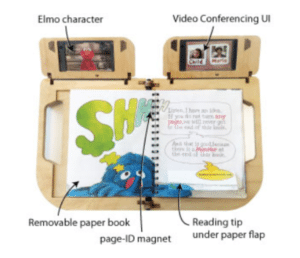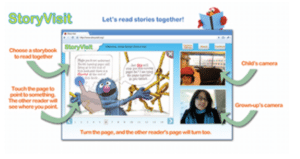Since launch, we are often asked how Hoot Reading came to be. Although we have only been around for about 6 months, the technology that powers Hoot has actually been in the works for almost a decade (!) and has strong basis in research from none other than Sesame Street. Yup, the same Sesame Street that Big Bird and his friends live on.
A lot of people don’t know this, but Sesame Workshop is actually the largest informal educator of children in the world. They (and their internal think-tank, The Joan Ganz Cooney Center) have a huge team of researchers whose job is to understand how children can learn from new and emerging technologies.
In 2008, Sesame and JGCC struck up a partnership with the Nokia Research Center in Palo Alto to better understand how video chat applications like Skype – which at the time was just becoming mainstream – could support cooperative play and learning at a distance.
 Our first prototype combined physical books, video chat and kids favorite friend Elmo. This system allowed adults to read physical books to children over video chat. Interestingly, Elmo didn’t read the story, but listened intently to the reader modeling an interest in reading. Elmo would also ask questions about each page, modeling dialogic reading techniques, and encouraging children to talk about the book.
Our first prototype combined physical books, video chat and kids favorite friend Elmo. This system allowed adults to read physical books to children over video chat. Interestingly, Elmo didn’t read the story, but listened intently to the reader modeling an interest in reading. Elmo would also ask questions about each page, modeling dialogic reading techniques, and encouraging children to talk about the book.
Research on dialogic reading demonstrates that children learn more by talking about a book during the reading experience. This initial prototype allowed us to rediscover the natural links between video communication and children’s learning. While our research prototype was not easy to scale, we extracted important lessons from this work, in particular how to create shared reading activities at a distance and how to engage both kids and adults.
One thing we learned is the importance of what we now call the “magic finger”. This is a shared pointer that allows each side of the call to point to things in a book and see where each other is pointing. For example “Miss Lindsay, what is that letter?”, or “Sammy, can you read this word for me”. This back and forth is really what guided reading is all about, and is made possible at a distance through our magic finger.
 A website was the next in the iterative evolution of our ideas. To make content coordination on both sides easier, we used ebooks, instead of physical books. In the summer of 2010 we were able to deploy the system and study it “in the wild”. We observed families using our service in their homes. We found that these connected book reading session were significantly longer than typical video chat sessions and it was clear to us that the kids were enjoying them, too.
A website was the next in the iterative evolution of our ideas. To make content coordination on both sides easier, we used ebooks, instead of physical books. In the summer of 2010 we were able to deploy the system and study it “in the wild”. We observed families using our service in their homes. We found that these connected book reading session were significantly longer than typical video chat sessions and it was clear to us that the kids were enjoying them, too.
Although the web service was scalable, mouse control is very difficult for young children, especially if they trying to put all of their “cognitive energy” towards the reading itself. When Apple came out with the iPad, the combination of the touch screen, device size, and distribution method presented the perfect medium – and our App was born!
Within the Hoot Reading App, teacher and student can see and hear each other over video chat – just like they would on Skype or Facetime. They have a library of over 600 levelled readers to choose from. Once a book is chosen, it appears on both teacher and students screen simultaneously, and page turns are synchronized. Both sides can see where each other is pointing, allowing for the aforementioned dialogic reading.
The greatest compliment we get about our App is that it “fades into the background, and feels as though the teacher and student are together in the same place”. This is ironic, when you think of all of the hard work and research that went into developing the technology. But really, isn’t that how good educational technology often works – the technology fades into the background so that the focus becomes on the connection between the teacher and the learner?
